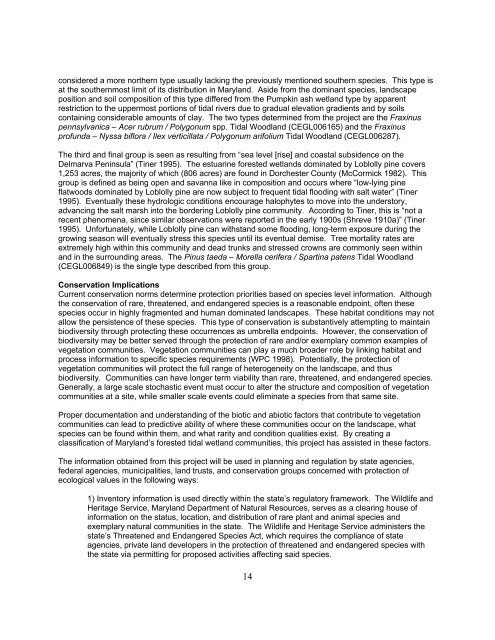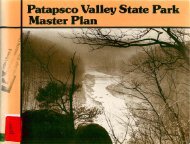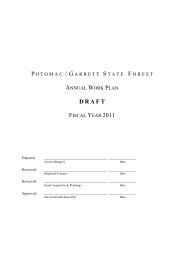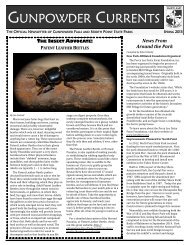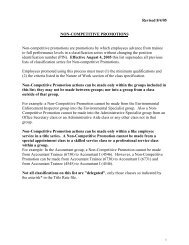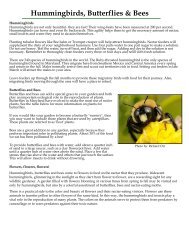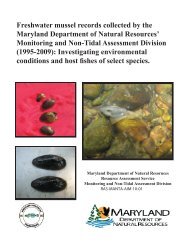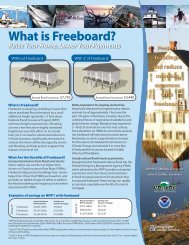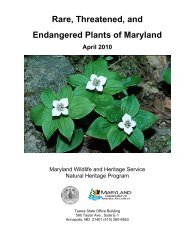tidal hardwood swamps - Maryland Department of Natural Resources
tidal hardwood swamps - Maryland Department of Natural Resources
tidal hardwood swamps - Maryland Department of Natural Resources
Create successful ePaper yourself
Turn your PDF publications into a flip-book with our unique Google optimized e-Paper software.
considered a more northern type usually lacking the previously mentioned southern species. This type is<br />
at the southernmost limit <strong>of</strong> its distribution in <strong>Maryland</strong>. Aside from the dominant species, landscape<br />
position and soil composition <strong>of</strong> this type differed from the Pumpkin ash wetland type by apparent<br />
restriction to the uppermost portions <strong>of</strong> <strong>tidal</strong> rivers due to gradual elevation gradients and by soils<br />
containing considerable amounts <strong>of</strong> clay. The two types determined from the project are the Fraxinus<br />
pennsylvanica – Acer rubrum / Polygonum spp. Tidal Woodland (CEGL006165) and the Fraxinus<br />
pr<strong>of</strong>unda – Nyssa biflora / Ilex verticillata / Polygonum arifolium Tidal Woodland (CEGL006287).<br />
The third and final group is seen as resulting from “sea level [rise] and coastal subsidence on the<br />
Delmarva Peninsula” (Tiner 1995). The estuarine forested wetlands dominated by Loblolly pine covers<br />
1,253 acres, the majority <strong>of</strong> which (806 acres) are found in Dorchester County (McCormick 1982). This<br />
group is defined as being open and savanna like in composition and occurs where “low-lying pine<br />
flatwoods dominated by Loblolly pine are now subject to frequent <strong>tidal</strong> flooding with salt water” (Tiner<br />
1995). Eventually these hydrologic conditions encourage halophytes to move into the understory,<br />
advancing the salt marsh into the bordering Loblolly pine community. According to Tiner, this is “not a<br />
recent phenomena, since similar observations were reported in the early 1900s (Shreve 1910a)” (Tiner<br />
1995). Unfortunately, while Loblolly pine can withstand some flooding, long-term exposure during the<br />
growing season will eventually stress this species until its eventual demise. Tree mortality rates are<br />
extremely high within this community and dead trunks and stressed crowns are commonly seen within<br />
and in the surrounding areas. The Pinus taeda – Morella cerifera / Spartina patens Tidal Woodland<br />
(CEGL006849) is the single type described from this group.<br />
Conservation Implications<br />
Current conservation norms determine protection priorities based on species level information. Although<br />
the conservation <strong>of</strong> rare, threatened, and endangered species is a reasonable endpoint, <strong>of</strong>ten these<br />
species occur in highly fragmented and human dominated landscapes. These habitat conditions may not<br />
allow the persistence <strong>of</strong> these species. This type <strong>of</strong> conservation is substantively attempting to maintain<br />
biodiversity through protecting these occurrences as umbrella endpoints. However, the conservation <strong>of</strong><br />
biodiversity may be better served through the protection <strong>of</strong> rare and/or exemplary common examples <strong>of</strong><br />
vegetation communities. Vegetation communities can play a much broader role by linking habitat and<br />
process information to specific species requirements (WPC 1998). Potentially, the protection <strong>of</strong><br />
vegetation communities will protect the full range <strong>of</strong> heterogeneity on the landscape, and thus<br />
biodiversity. Communities can have longer term viability than rare, threatened, and endangered species.<br />
Generally, a large scale stochastic event must occur to alter the structure and composition <strong>of</strong> vegetation<br />
communities at a site, while smaller scale events could eliminate a species from that same site.<br />
Proper documentation and understanding <strong>of</strong> the biotic and abiotic factors that contribute to vegetation<br />
communities can lead to predictive ability <strong>of</strong> where these communities occur on the landscape, what<br />
species can be found within them, and what rarity and condition qualities exist. By creating a<br />
classification <strong>of</strong> <strong>Maryland</strong>’s forested <strong>tidal</strong> wetland communities, this project has assisted in these factors.<br />
The information obtained from this project will be used in planning and regulation by state agencies,<br />
federal agencies, municipalities, land trusts, and conservation groups concerned with protection <strong>of</strong><br />
ecological values in the following ways:<br />
1) Inventory information is used directly within the state’s regulatory framework. The Wildlife and<br />
Heritage Service, <strong>Maryland</strong> <strong>Department</strong> <strong>of</strong> <strong>Natural</strong> <strong>Resources</strong>, serves as a clearing house <strong>of</strong><br />
information on the status, location, and distribution <strong>of</strong> rare plant and animal species and<br />
exemplary natural communities in the state. The Wildlife and Heritage Service administers the<br />
state’s Threatened and Endangered Species Act, which requires the compliance <strong>of</strong> state<br />
agencies, private land developers in the protection <strong>of</strong> threatened and endangered species with<br />
the state via permitting for proposed activities affecting said species.<br />
14


